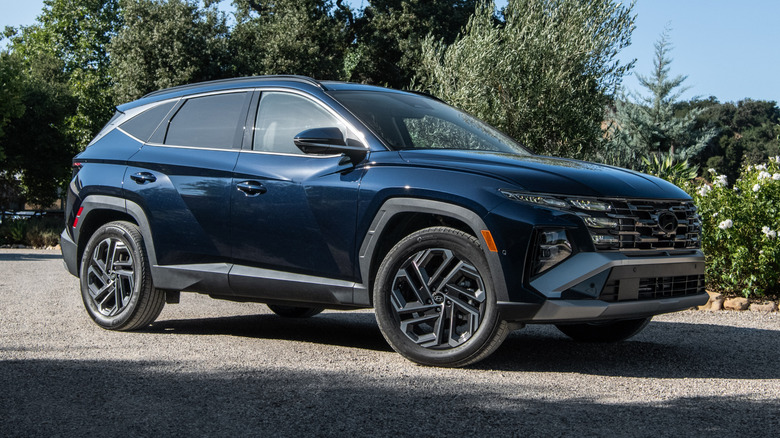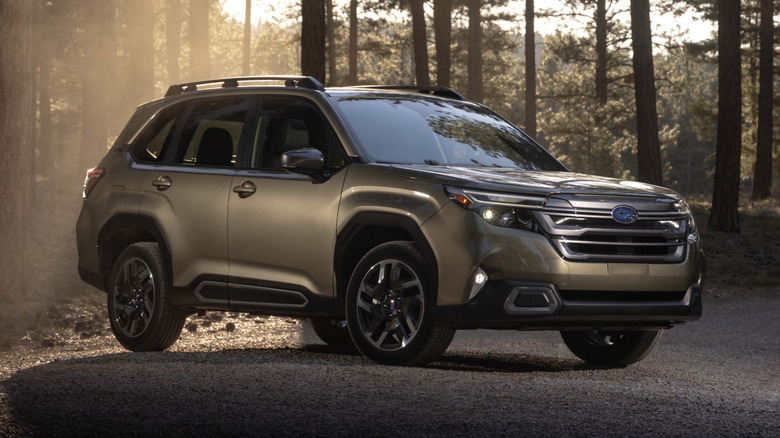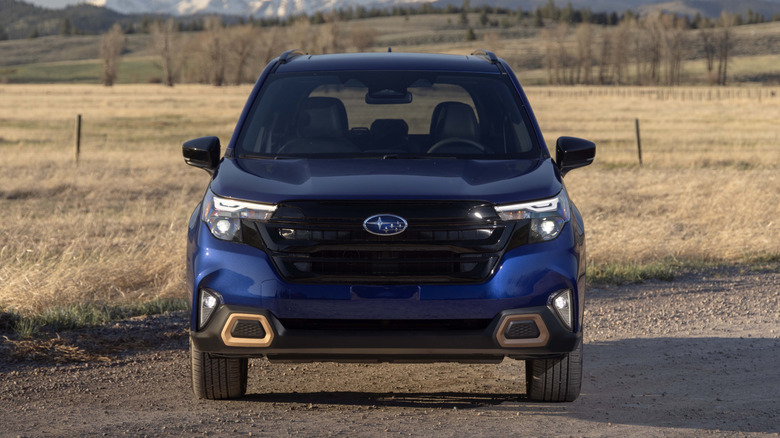These Small SUVs Are Comfortably Spacious, According To Consumer Reports
SUVs offer a higher ride height and often boast better all-terrain capability than sedans or hatchbacks, but despite their added heft, not all of them are particularly spacious inside. To make matters worse, plenty also offer lower gas mileage figures than lower-slung cars, although the most frugal 2025 models can now get well over 30 mpg. Smaller SUVs are often more efficient, although buying a compact SUV to save on fuel can sometimes mean compromising on space.
However, there are some exceptions to the rule. These five compact SUVs were selected by Consumer Reports as being among the most spacious in their class, with plenty of room for both passengers and their luggage. SlashGear's review team has put each car to the test, assessing qualities like their ride comfort, tech features, and capability both on and off the road. This is what we thought about each of CR's latest batch of top picks.
Hyundai Tucson
Hyundai frequently updates its lineup with styling tweaks, new tech, and additional options, and the Tucson is no different. For 2025, the Tucson is available as a hybrid or gas model, with a minor exterior makeover that includes new daytime running lights. The interior is updated too, with a new 12.3-inch infotainment touchscreen that includes wireless Apple CarPlay and Android Auto. In our first drive of the 2025 Tucson hybrid, we found its infotainment system to be intuitive to use, and the updated upholstery options gave the Limited trim a surprisingly upmarket feel.
Front-wheel drive and all-wheel drive options are available, with the latter being paired with beefier tires and a 2.5-liter gas engine in the all-terrain XRT trim. Despite serious off-roading being out of the question, the XRT also offers center locking differentials too. Meanwhile, the hybrid powertrain will be the mill of choice for buyers looking to keep their fuel bills to a minimum, offering up to 38 mpg combined.
The Tucson offers plenty of space for taller occupants in both the front and rear rows, and our 6-foot-1-inch writer found both rows comfortable. Both the ICE and Hybrid models have a maximum of 41.2 cubic feet of cargo capacity with the rear seats up. Hyundai also offers a plug-in hybrid version of the Tucson, but it's less roomy and notably pricier, and so isn't as good a value proposition as either the hybrid or ICE variants. The base trim starts from $30,200 (including a $1,495 destination fee) for 2025.
Subaru Forester
Much like its rivals, the 2025 Subaru Forester is available with or without a hybrid powertrain. While the hybrid gets better gas mileage on paper, we calculated that it would take the average American driver well over a decade for the fuel cost savings to pay off. The driving experience for either powertrain isn't all that different — the Forester is not a car that you buy because it's fun to drive. Instead, it's intended to be capable, reliable, and comfortable, and it delivers on all of those key criteria.
It's also spacious enough for a family and their stuff, with pets also well catered for in the Subaru's decently proportioned trunk. The car offers 29.6 cubic feet of cargo space with the rear seats up. It isn't without its flaws, with our reviewer highlighting the Starlink infotainment system as a particular pain point during our week of testing. However, on the whole, the Forester continues to deliver the same easy, comfortable driving experience that fans of the brand will expect, all for a reasonable price tag. The 2025 model starts from $31,415 (including a $1,420 destination fee).
Honda CR-V Hybrid
The 2025 Honda CR-V Hybrid doesn't do anything radical. It's quiet, comfortable, and attractively priced, and it retains the same solid build quality that Honda buyers will be familiar with. The 2025 CR-V is available with or without a hybrid powertrain, with buyers who don't want the added electrification able to opt for a 1.5-liter turbo-four engine instead. Many of the CR-V's biggest rivals offer impressively high efficiency figures, and while the Honda is competitive on paper, we found its real-world mpg figures to be significantly below the manufacturer's claims.
The driver assistance features also got grating fairly quickly, with the blind spot monitoring system throwing out multiple false alarms on highway drives during our test period. Other than those drawbacks, there was relatively little to dislike about the car — it's impressively spacious, decently equipped, and can be optioned with all-wheel drive for extra reassurance in winter weather. Its standard 39.3 cubic feet of cargo space provides plenty of room for luggage or pets, while the CR-V Hybrid's $36,100 starting price (including a $1,450 destination fee) keeps it broadly competitive with other top sellers in its segments.
Toyota RAV4 Hybrid
It isn't quite as roomy as some of its rivals, but the 2025 Toyota RAV4 Hybrid still has 37.5 cubic feet of cargo space with the rear seats up. It will still seat adults in the rear too, although again, they won't have quite as much legroom as in the RAV4's roomiest competitors. Rather than sheer space, the RAV4 Hybrid earns its spot as a top performer in the segment by combining a frugal hybrid powertrain with Toyota's reputation for reliability. Add in an exterior design that's sleek yet inoffensive and a ride that's smooth if never exciting, and the recipe for a sensible, compact family hauler is complete.
The RAV4 Hybrid comes loaded with Toyota's Safety Sense 2.5 as standard, although it isn't quite as generous with its standard tech as either the Hyundai Tucson or Kia Sportage. The car's infotainment system also feels less cutting-edge than some rivals — although not to the point of being dated. There are plenty of buttons and dials around the dash and center console, which should please buyers that aren't so keen on being forced to control their car's functions through a touchscreen. It might have plenty of competition, but the RAV4 Hybrid is still a strong contender in its segment, with a starting price of $34,300 (including a $1,450 destination fee) for 2025.
Kia Sportage Hybrid
Keen to keep its bestselling SUV appealing in a fiercely competitive segment, Kia has given its Sportage Hybrid SUV a makeover for the 2026 model year. Its looks have been overhauled, both inside and out, while its infotainment system has also been spruced up. New, upscale-looking upholstery is available for select trims, and inevitably, Kia's pricing structure for the car has also changed a little. It's still affordable though, with the base trim starting from $31,735 (including a $1,445 destination fee).
The car's 34.5 cubic feet of cargo space isn't best in class, but it's a competitive figure, and the headroom and legroom for both rows is also on par with its key rivals. Buyers willing to cough up for a top-spec trim will be rewarded with a premium feeling cabin that can be optioned in a variety of colors, but even base-spec examples shouldn't feel too spartan inside thanks to the plentiful standard safety tech.
How we evaluated these SUVs
To compile this list of roomy, comfortable compact SUVs, we used Consumer Reports' top picks as a starting point. We then drew on the wealth of experience from our review team to add insight into each car's strengths and weaknesses. Prices listed for each model reflect the manufacturer's retail price for a base trim car with no additional options.






